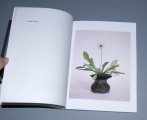

#1
Two springs ago, Diana Scherer tipped a tub of soil out on her balcony and sowed wildflowers. Months later she photographed the resulting bunch of flowers as a classic still life. More than just recording a composition or arrangement, her photos document an extended sculptural and botanical investigation.
I
Process is key in Scherer’s work. With Nurture Studies, the artist presents an archive of flowers she has grown from seed over a six-month period. Rather than letting the flowers grow in open soil, she has forced each plant to develop within the confines of a vase. Only at the end of the process does she remove the plant’s corset, exposing roots that retain their shape as an evocation of the now absent vase.
There is an inherent contradiction in Scherer’s working method. Although she is dedicated to the project and keeps a close eye on whether the roots are developing as desired—checking them carefully and with the utmost precision—her ability to manipulate the plants’ growth is limited. She has to accept the impossibility of total control. This contrast between almost obsessive monitoring and an inability to fundamentally influence events becomes an intense, almost ritual presence in her work. Sherer’s photos are carefully rationed, showing a single moment as the culmination of a long process of growth. She documents the flowers at their peak, just before they begin to shrivel as the plants start to die.
II
Scherer has always been fascinated by flowers. Although not always prominent in the foreground, they have often played a role in her work. Examples are a dead deer lying on a bed of flowers (Anthology, 2008) or women in floral dresses hanging from the branches of trees (Women, 2004). It is only in her most recent series that she has concentrated on the flower as such, transforming her fascination into an obsession. As a fanatical collector, she has amassed an arsenal of material related to the object of her desire: old garden encyclopaedias, botanical guides, porcelain cups with floral motives and pieces of toilet paper embossed with floral designs. This compulsive collecting lays the groundwork for the images she ultimately records with her camera.
The photos Scherer has produced for Nurture Studies recall the illustrations in seventeenth-century botanical encyclopaedias, which presented flowers roots and all. Her work also has strong similarities with 1970s plant books, in which indoor plants were often arranged on a pedestal and set off with fabrics that added a romantic touch to the whole. Although clearly referring to these predecessors, Scherer has no difficulty avoiding the perceived cosiness of the “pot plant”-genre. Her images are bare, unadorned. The careful observer will notice that most of the plants are anything but perfect specimens. Brown edges and broken stems show that mortality is already making its presence felt. The pink aster’s leaves are already dying off and other plants, dandelion and cow parsley for instance, wouldn’t be deemed worthy of a second glance on the side of the road. Scherer treats them all as equals.
III
The floral portraits form a pendant to earlier photo series in which Scherer opted for much rawer imagery, things like young girls lying on the ground with their backs to the camera, collapsed like rag dolls, so that viewers almost automatically think of them as victims (Mädchen, 2002-2007). In Nurture Studies this confrontational imagery has made way for subtlety. Although the flowers, with their exposed roots, look just as fragile as the girls, Scherer avoids any semblance of drama, mainly by the objectivity of her photographic style, arranging the plants upright in the frame and photographing them with a technical camera. This approach is consistent with the orderly way collectors catalogue their objects.
Behind this objective methodology, there is a great deal of emotion at work. More than anything else, Scherer’s process of collecting, nurturing and documenting is a display of tenderness, ritualistic love that remains hidden to the viewer, but still infuses the vulnerable final images with its almost tangible presence.
